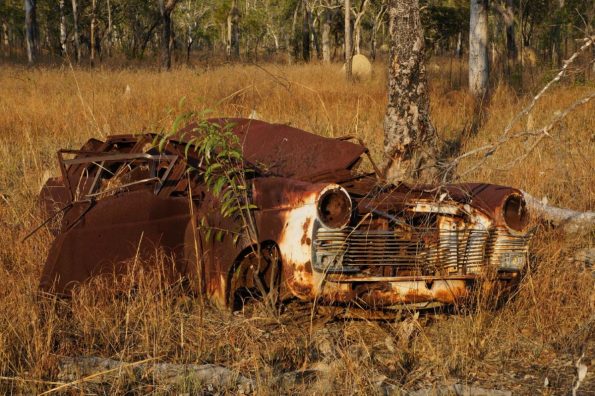A car crash sounds like a simple thing: one car hits another car, things get cleared away and then people get on with their lives. It couldn’t be further from the truth, though. In reality, vehicle crashes cost our economy billions and billions of dollars per year.

The occasional wrecked car is easy to spot in certain areas of rural Australia, like this one we found on the way to Chillagoe, QL
One car single car crash can easily affect tens of thousands of people and cause millions of dollars worth of losses. Here’s how:
- The passengers in the vehicles – even if they escape injury, there may be psychological effects which cause ongoing problems that affect their life. They might have nightmares that disrupt their sleep and give them fatigue, or they could be afraid of driving again. If they are injured then they could have a lifetime of medical and rehabilitation requirements. Many relationships suffer and ultimately fail if there is a major crash trauma.
- Family and social network – a person is connected in many ways to other people: their family and friends, work colleagues and clients, and people they regularly buy services from such as the local shop. In the case of serious injury, a family member might have to give up work to become a primary caregiver. If a child loses a parent it can affect them deeply.
- Knowledge – some people have very specific knowledge that can die with them. This knowledge could be used for improving the world, such as people who research medical cures, inventors who create products which reduce our environmental impact, or entertainers who bring joy to millions of people.
- Rescue personnel – it’s the job of rescue personnel to deal with crashes, but even hardened and experienced first responders can be left traumatised by what they see. This can affect their personal life.
- Medical staff – If the passengers have injuries then they will need to be seen by medical staff at a doctor’s surgery or, for more serious injuries, at a hospital. This might involve helicopter rescue or ambulance staff if the accident is serious. There are ongoing support and rehabilitation staff required for more serious injuries.
- Funeral – if one or more of the passengers are killed there are all the associated funeral costs and procedures.
- Road users – serious accidents can cause holdups which cost the economy millions of dollars. Thousands of people can be stuck in long traffic queues which delay deliveries, prevent meetings from happening and can even cause loss of life when emergency services vehicles are delayed. Insurance costs increase with every accident so, in the end, everyone with insurance ends up paying a little bit towards the crash.
- Legal system – if the driver who caused the accident is prosecuted taxpayers pay for the legal system. This ties up court time and resources. If the driver is incarcerated, the taxpayer picks up the bill for the prison time.
- Tradespeople and roading contractors – contractors will come along to repair any damage to fences and private property, and any damage to the road. This cost could be borne by the taxpayer if the driver doesn’t have insurance.
- Nature – some crashes start bush fires which can affect other people as well as the nature that lives there. Destroying a natural environment reduces its amenity value. Fences that are destroyed could let livestock out which then become a further road hazard, plus it costs the farmer to round them up. If fluids such as petrol and oil are spilled into waterways it creates pollution. Plus, if the vehicles are destroyed then they don’t live to their full potential based on the cost to mine the materials out of the ground and produce a car out of them.
A number of people that have to respond to an accident use vehicles which burn fuel which increases our atmospheric CO2 and other pollutants and this indirectly affects many Australians. The decline in air quality through traffic delays caused by the crash results in greater chance of respiratory disease in the surrounding population, increasing health costs. - Vehicle services – as we import a lot of vehicles in Australia, if a vehicle is written off it will most likely be replaced by one that has been made overseas, and that worsens our balance of trade, causing Australian dollars to flow out to other countries. If the vehicle is able to be repaired then parts need to be sourced and fitted by a mechanic. If the vehicle is a company vehicle then there is a loss of productivity to the company and a hard cost in insurance excesses and hiring or purchasing a replacement vehicle.
Many of these factors are measured in the social cost of an accident. It attempts to measure the loss in potential of that person had they continued to live a normal life – what they could have contributed to society – and the impact on and costs associated with managing the crash. Back in 2010 the estimate was between $2,400,000-6,000,000 per fatal crash, and it will undoubtedly be much more now.
For more information on the calculations for the social cost of vehicle crashes, this report by the Department of Infrastructure and Regional Development has more detail.
